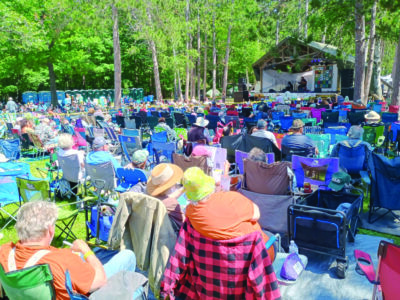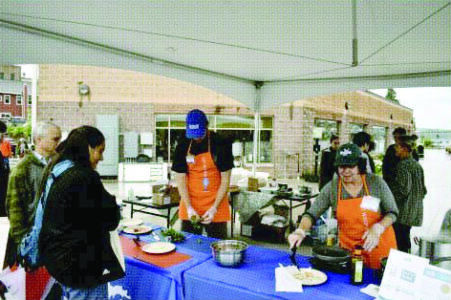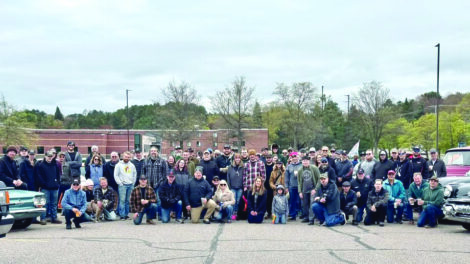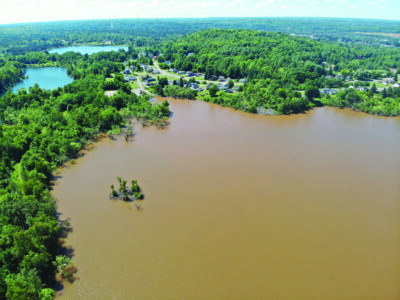Fresh Fish Fest returns to Houghton

Wyatt Slack and Sharon Moen prepare strawberry salsa walleye tacos for attendees at the Mi Fresh Fish Fry on Friday at the Houghton Pier. Slack works as an intern at the facility which raised the walleye served at the event and educated the public about farm raised fish. (Houghton Daily Mining Gazette photo)
HOUGHTON — Mi Fresh Fish Fest hosted by Michigan Sea Grant returned to the downtown Houghton Pier for its second year Friday to educate the public on local fisheries, fish biology and studies, introduce people to ways of preparing fish and raise awareness of local commercial fishing. The fest began with the Mi Fresh Fish Sail on the schooner, the Inland Seas, and then proceeded in the late afternoon with the Mi Fresh Fish Fry. Despite rain early, there was a large turnout of folks looking to learn about aquaculture and sample some of the fish dishes.
The Mi Fresh Fish Sail allowed participants to sail the schooner on Lake Superior where they learned about fish identification, the Mi Fresh Fish organization and were told some traditional stories. Some of the topics of fish identification included discussions on invasive species, such as the sea lamprey.
Fisheries and Aquaculture Educator with Michigan State University Extension and part of the Michigan Sea Grant, Lauren Stigers said the event was important to serve as a reminder of local fisheries and the value they possess. “Many people do not know we have commercial fishing in the Great Lakes, or aquaculture in Michigan or fish farming,” Stigers said. “And so it’s (event) really to bring awareness that these industries exist, but then also to celebrate our local fisheries that we have right here in our backyard as well, whether you catch it yourself or you buy it at the store.”
Stigers explained 90 percent of seafood in the U.S. is imported and therefore not as fresh as fish harvested within the country. She said the fest serves as a way to show what is available and to address misconceptions or misinformation there might be regarding local fisheries. Stigers said that about half of the vendors at this year’s fest were new compared to last year. Some new additions included Copper Country Mental Health and Western U.P. Food Systems.
Copper Country Mental Health Director of Training and Prevention Services Taryn Mason said a collaboration with the Wester U.P. Food Systems includes a program which provides nutrition education, and the Mi Fresh Fish Fry presented the opportunity to do such since fish can be a healthy dietary choice. “We’re just normalizing mental health and spreading that mental health services are for everybody, kind of like your physical health, it’s important to be mentally healthy,” Mason said. So we want everybody to know that it’s important if you need help, to get help.”
Aquaculture was a large focus of the event, and Amy Schrank of Sea Grant Minnesota presented a display of a recirculating aquaculture system with six brood stock brook trout from the KBIC hatchery. The tank would would transfer water to a filter which would filter solids, fish waste and other unwanted particles. It also had a biological filter to grow algae and absorb nutrients, which would then recirculate the clean water back to the main tank for the fish with little if any water lost in the systems. “Aquaculture is a sustainable way to raise local fish,” Schrank said. “So for and people raise fish for food stocking, ornamental fish or aquarium fish, they raise bait in aquaculture, but most of the seafood in the United States is from imports. So for a more local sustainable supply, we encourage people to think about aquaculture grown fish.”
Some of the fish served at the event was the result of aquaculture. The fest provided two dishes, walleye tacos with strawberry salsa and whitefish boil. The walleye came from the Northern Aquaculture Demonstration Facility in Bayfield, Wisconsin. Aquaculture Intern for Sea Grant Wisconsin Wyatt Slack raised the walleye he was cooking for visitors. “We had brought some walleye that we had raised from the larval stage at our facility out to cook and make into some tacos,” Slack said. “We wanted to show people that fish from inside, farm fish can be just as tasty and as healthy as fish raised outdoors and are caught wild.”
Slack started his internship nine weeks ago and his experience changed his initial impression of farm raised fish. He said he shared the view with many who believe farm fish are dirty and unhealthy, but his experience taught him about the inner workings of raising fish and he has changed his perspective. Slack has pride in the work he conducted leading to the fish fry. “I’m really happy that people are enjoying this. I missed the spawning of the walleye by about 10 days when I started my internship, but after that 10 days, I’ve raised them for nine weeks, and I can see them go from smaller than half your fingernail, to pretty decent size, about inch to an inch and a half long, which doesn’t sound like a lot but when you see how small they get at the beginning, and the tiny eggs they come from, and then eventually I see some of our broodstock when they get older and they start spawning with themselves, it’s really cool to see that you played a part in that,” Slack said.
Aquaculture was not the only science-based topic at the fish fry however, with Michigan Tech on had with two booths to inform the public of studies regarding Great Lakes fish species. Tech student Quinn Angus showed the food web of Lake Superior and how all species are interconnected starting from the smallest organisms all the way to large trout. Angus is studying fish otoliths, the inner ear bones of fish and observing the connection between changing climate and overall fish growth. Otoliths can reveal how old a fish is.
The other booth had PhD student Greyson Wolf taking angler surveys regarding burbot. Wolf is part of a project studying burbots’ population, genetics and diet. The project also includes a social aspect which is taking into account anglers’ perceptions of the fish. The burbot is a species not regulated by the DNR, and Wolf said because of this it is valuable to learn more about burbot and how much of a target they are becoming to anglers. “It’s always good to get involved in local outreach,” Wolf said. “That’s a really big part of science. Science is communication, because there’s really no point in doing science if you’re not sharing it around and telling people.”
The Keweenaw National Historical Park and the Calumet-Keweenaw Sportsmen’s Club was also present as part of their Junior Angler Program. The two groups have been a team all summer with KBIC to conduct a variety of fishing activities and educational events to raise children’s interest in fishing. At Mi Fresh Fish Fest, they were handing out angler information and spreading the word of upcoming summer events, as well as providing a fish identification game for children. Several fish images with magnets were lined on the ground, and the children were handed a fishing pole with a magnet. Once they caught the fish, the children would try to identify the fish and then read a fish fact on the back of the image.
Interpretation and Education Ranger Karl Larson said it was also important to combine fishing with local history. “Copper mining was huge in the Copper Country,” Larson said. “So were other industries related to the copper mining industry, like logging. Logging really changed the habitat of rivers, especially widening them.” Larson said being invited to the Mi Fresh Fish Fest was great for the angler program, and contributes to the festival’s education component. “It’s great to be invited to this. It’s a program that we’re trying to grow. In the last couple years we’ve been growing this and being able to to join in on something like this is helpful for everybody involved,” he said.





